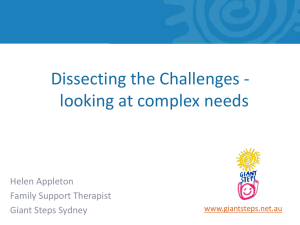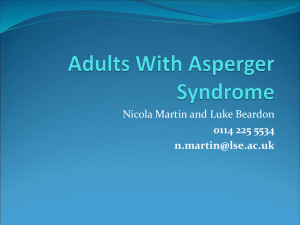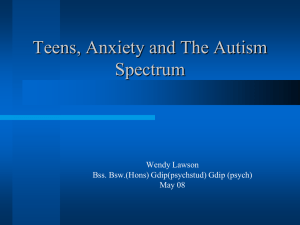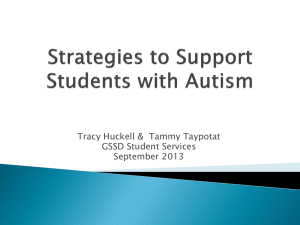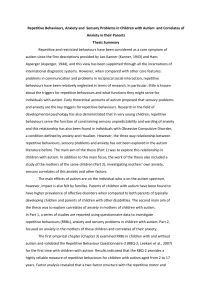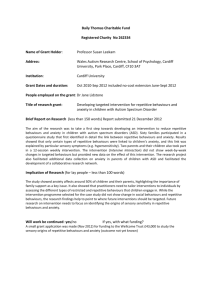File - Autism Friendly Practice
advertisement
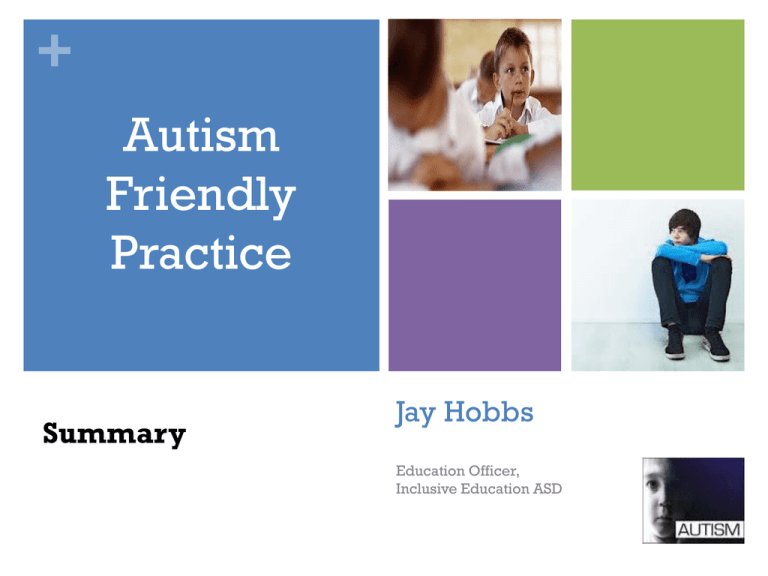
+ Autism Friendly Practice Summary Jay Hobbs Education Officer, Inclusive Education ASD + KEY ELEMENTS Understand autism Adjust environment Support curriculum access Support management of anxiety + Autism in Australia 1 in 160, Australian children aged between 6 and 12 years have Autism (Australian Advisory Board on Autism Spectrum Disorders, 2007) Which constitutes more than the number of children with cerebral palsy, diabetes, who are deaf, or blind and have leukaemia combined. + Research Indicates In a prospective study of 1,012 children in the United States of America. Suicide ideation or attempts was found to be 28 times greater in autistic children than that of non autistic children (14% as opposed to 0.5%). Rates of suicide ideation or attempts increased from 6% to 46% in autistic children with one to three of these comorbidity risk factors (teasing, depression, or behaviour problems). (Gorman, Research in Autism Spectrum Disorders, 2013) + … but, people with autism succeed when they: • understand and manage their strengths and weaknesses • achieve academically at school • are accepted by their peers The term autism is often used synonymously with ASD The diagnosis Autism Spectrum Disorder Low Functioning (with II) High Functioning (Asperger’s Syndrome) + Characteristics of Autism Triad of Impairments (Wing, 1979) Communication Social Rigid & Repetitive Behaviour + Educational Impacts Difficulties include Understanding Fitting In Coping + Summary Coping – differences in the brain cause extreme sensory overload or a need for high stimulation coupled with difficulty generating new ideas for what to do in a new situation. Understanding – differences in processing information (detail focus) causes students to misread or not understand social cues. Students desperately want to have friends but don’t know how to do it. Fitting in- differences in the brain causes students to feel like they are in a foreign country negotiating a foreign language and culture. + Understanding Autism at School Video http://www.youtube.com/watch?v=4yA AOI6JUsM + Evidence Based Key Strategies Chill Zone (Break Space) Where in the school it happens How do you staff it? How does it work? Lunch Clubs (structured social interaction) Where in the school they happen How do you staff it? How does it work? + Understanding Autism In the classroom http://www.youtube.com/watch?v=veQKD DE9C_w + Key Strategies Strategy Examples Priming • • Study guides Adjustments Visual Supports • • • • • Class schedule for the lesson Self management tools e.g. Task Steps and Tick’ clock and timing prompt Assessment Schedule Graphic organisers Social script Break Space • • Option to take a break to avoid anxiety Take a note to the school secretary Reinforcement • • • Verbal acknowledgement Previously discussed reinforcement of choice Link to self monitoring Transitions • Plan protocols: to class, between classes, from one topic to another + Summary Eng Arts HPE Design Tech RE Sc’s Math Language Language Prac subjects Coping Computing Understand Prac Theory Fitting in + Curriculum Access Plan Process: 1. Teacher and STIE discuss the impact of the student’s ASD on learning and together adjustments are chosen. 2. Parents and the student (where possible) are consulted. 3. Adjustments are recorded on a Curriculum Access Plan 4. Adjustments are actioned. + High Anxiety Sensory Sensitivity Communication Behaviour + The Rage Cycle RAGE RUMBLING Trigger RECOVERY + Understanding Anxiety It is important for school staff to understand that a student ‘meltdown’ is an expression of being overwhelmed by the Meltdowns anxiety Understanding that comes with the disability. The student is not choosing poor behaviour, rather, s/he is not managing anxiety well enough. + If our student does not know how to: Recognize Match Self emotions emotions to events calm Whose issue is a meltdown at school? + Autism & Behaviour http://www.youtube.com/watch?v=L K5Pr9h10BY + When the the rage cycle starts all opportunities for student learning are gone for some time. + Triggers The trigger refers to the context (“circumstances” or “situation” ) in which a person behaves. The trigger is not only the specific stimulus (or event) that immediately precedes the behaviour. It is just as important to look for triggers that support a student’s appropriate behaviours as it is to look for those that support problem behaviour. + Adult Curve Remain supportive and manage your own curve Use a quiet calm voice Prevent a power struggle Re-evaluate Be student goals flexible (the student cannot) Offer an alternative or clear choice + Rumbling Most important stage, student has some thinking ability intact, build up to rage Behaviours Fidgeting Antiseptic bouncing Making Proximity control Support from routine Chill zone (in / out class) Acknowledge student difficulties noises Refusing to cooperate Increasing volume Swearing voice Strategies + Rage shouting, swearing, hitting, out of control neurotransmitters are not working correctly, Behaviours Explosive Protect the student, other students Screaming Self Don’t discipline during this stage injury Hitting kicking Emotional Destroying Strategies Remove Follow property Call the audience a plan for assistance + Recovery The beginning of returning to baseline, Behaviours Sleeping Strategies Allow rest, relaxation Potential Do to return to rage Fragile May deny rage behaviours Apologizing not re escalate the situation (not time to learn yet) Do not make excessive demands Support with structure + Anxiety Management Teachers need to support student management of their anxiety because: Each meltdown adds to the student’s already poor self esteem, self concept and sense of control. This combination leads to poor mental health. Meltdowns disrupt the student’s efforts to be accepted and fit in with peers. Meltdowns disrupt the learning of other students. Meltdowns interrupt the student’s own learning + Meeting the needs of all parties Student To be understood To experience compassion To understand what is, and was, happening To learn better ways of coping with anxiety Teacher To keep all students safe To be able to teach To be supported with a student with ASD To be successful in managing the student Other students To be safe To be able to learn To feel that the school manages ASD well To know what to do during and after a rage School leaders To ensure the safety of all students To ensure quality teaching and learning for all To maintain a supportive environment for all + What reduces anxiety? Predictability, so the student knows; • who they are working with • what the activities and motivators are for that day + Strategies to overcome sensory sensitivity + Blutac or fabric ( e.g. felt, fur) + Self-regulation + Teaching Social Skills What to do story + Social Autopsy 10 min Debriefing with a student after a meltdown is a very sensitive process. This is the time for learning to occur A useful tool to use at this time is the (Social Autopsy in the resources part of your folder) This is a positive way of identifying the social error and teaching the student what s/he might do next time Comments? + Rewarding appropriate behaviours Must be: Positive (not based on negative consequences) Motivating to student (NOT I will be happy if you) Immediate reward, token, sticker, star, puzzle piece Successful the first few times Reward idea + Reward idea + Teaching Social Skills Video Modeling with the iPad Video Self Modeling
